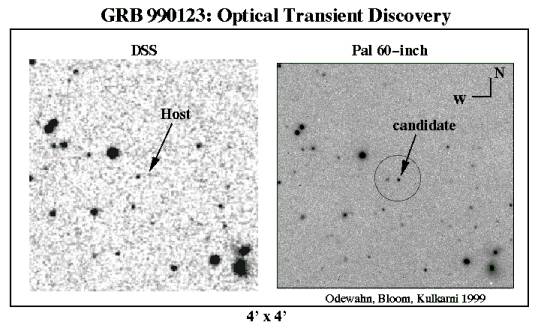Credit & Copyright: Courtesy
J.S. Bloom
(Caltech-CARA-NRAO
GRB Collaboration)
Explanation:
Gamma-ray bursts rule the high-energy sky and
Saturday another brief, intense flash of gamma-rays from
the cosmos triggered space-based detectors.
The orbiting Compton Observatory's
BATSE instrument quickly
relayed the burst's approximate location to
fast-slewing, ground-based cameras
primed to search for an elusive optical flash.
The result --
the GCN coordinated
ROTSE-I telephoto array recorded a
breakthrough detection
only 22 seconds after the burst trigger.
Larger telescopes too captured the burster's optical counterpart and
at right is an image identifying the candidate from
the 60 inch Palomar reflector.
At left is a prior sky survey image of the region which
astonishingly shows a discernible smudge near the same position,
likely the burster's host galaxy.
The galaxy and bright burst suggest that this is the closest
yet localized gamma-ray burst!
Still, believed to be the most
powerful explosions in the Universe,
the source of the incredible energy of gamma-ray bursts remains
a mystery.
Update: Reported redshift measurements now suggest that the burst is instead a very distant one. The galaxy in the survey image may not be the gamma-ray burst host but a foreground galaxy which by chance lies along the line of sight from Earth to the burster.
1999 2000 2001 2002 2003 2004 2005 2006 2007 2008 2009 2010 2011 2012 2013 2014 2015 2016 2017 2018 2019 2020 2021 2022 2023 2024 2025 |
Yanvar' Fevral' Mart Aprel' Mai Iyun' Iyul' Avgust Sentyabr' Oktyabr' Noyabr' Dekabr' |
NASA Web Site Statements, Warnings, and Disclaimers
NASA Official: Jay Norris. Specific rights apply.
A service of: LHEA at NASA / GSFC
& Michigan Tech. U.
|
Publikacii s klyuchevymi slovami:
gamma-ray burst - optical transient - gamma-vspleski - opticheskoe poslesvechenie - opticheskie oreoly gamma-vspleskov
Publikacii so slovami: gamma-ray burst - optical transient - gamma-vspleski - opticheskoe poslesvechenie - opticheskie oreoly gamma-vspleskov | |
Sm. takzhe:
Vse publikacii na tu zhe temu >> | |
